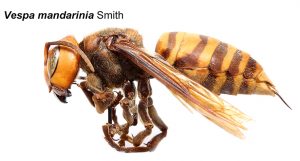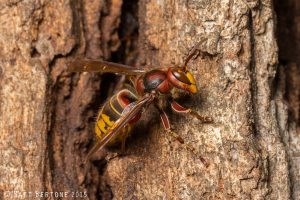(Note: This is a modified version of a post we have on the NC Cooperative Extension website.)

Asian giant hornet (Matt Bertone, NC State University)
The news media have been reporting that the Asian giant hornet (Vespa mandarinia) has been found in Washington state. This actually happened back in late 20191. Previously, it had been reported in British Columbia, Canada in September 2019. This hornet lives up to its name because the queens are more than 2″ long while the workers are about 1 1⁄2″ long. The “murder hornet” nickname has been attributed to them being responsible for the death of 50 people annually in Japan, much the same way that the term “killer bees” was applied to the Africanized honey bees as it made its way up from South & Central America and into the southern U.S. What is also true is that these giant wasps have a well-deserved reputation as a pest because they attack and can destroy entire bee colonies.
It’s extremely important to understand that this insect is not found in North Carolina and we have little reason to suspect it is present here (or will be present any time soon). However, over the years, we have received numerous calls and emails from people about finding “Japanese Hornets.” and the same is happening right now. In every case, what people were seeing were European hornets, Vespa crabro, which is no wimp itself.

European hornet worker (Matt Bertone, NC State)
Adult European hornets somewhat resemble yellowjackets, but are much larger (about 1 1⁄2″) and are brown with wide yellow markings. Queens of the Asian giant hornet are more than 2″ long while the workers are about 1 1⁄2” long (see image below). The Asian giant hornets have an almost entirely yellow-orange colored head. They have a dark thorax (the body section where the wings and legs attach) and the abdomen has dark brown and black bands. The head of European hornet (seen below) is reddish-brown, becoming yellowish near the face. Also, the eyes of Asian giant hornets are smaller in relation to the size of the head compared to European hornets.
European hornet queens are busy building nests which may be hidden in hollow sections of a tree trunk or in attics. If you see large wasps entering holes/gaps in roof fascia and soffits or going under decks, Although it will take several weeks for the numbers of new workers to start increasing, NOW is the time to act before their colonies begin to grow and produce workers that will defend the nest aggressively (based on first-hand experience!). Watch for signs of wasp activity in and around your home. According to data publish by the CDC for the years 2000-2017, an average of 62 people died annually from bee/wasp/hornet stings in the U.S. with about 80% of those cases being males. A study2 published in 2014 estimated that there are about 220,000 ER-visits annually due to bee and wasp stings.
Asian giant hornets are not an issue for us at this time and not likely to be one in the near future barring some accidental introduction (as was likely the case in Washington). However, everyone needs to be aware that we have a resident hornet species that, at first glance, appears similar to the Asian giant hornet. As with any bee/wasp/hornet sting, the greatest threat is for people who are highly allergic need to be careful outdoors. Regardless of whether or not you are sensitive to such stings, always be careful and watch for signs of bee/wasp activity. Use caution when approaching a wasp/hornet nesting site and be careful when working outdoors on items that have not been disturbed for some time (like piles of wood). If you find a wasp that fits the description of the Asian giant hornet, contact your local County Cooperative Extension Center
You can also submit images online to the NC Plant Disease and Insect Clinic (NCPDIC).
If you are a beekeeper, you can check out Asian Giant Hornets Not a Problem for NC Beekeepers…yet? by Dr. David Tarpy.
You can also read a blog post by Dr. Matt Bertone, Director of the NC Plant Disease and Insect Clinic. Plus, we have information about the European Hornets in North Carolina.
Reference cited:
2/ New Pest Response Guidelines – Asian Hornet, Vespa mandarinia. USDA-APHIS
2/ Langley, R.L., Mack, K., Haileyesus, T., Proescholdbell, S., and Annest, J.L. National estimates of noncanine bite and sting injuries treated in US hospital emergency departments, 2001–2010. Wilderness Environ Med. 2014; 25: 14–23>

